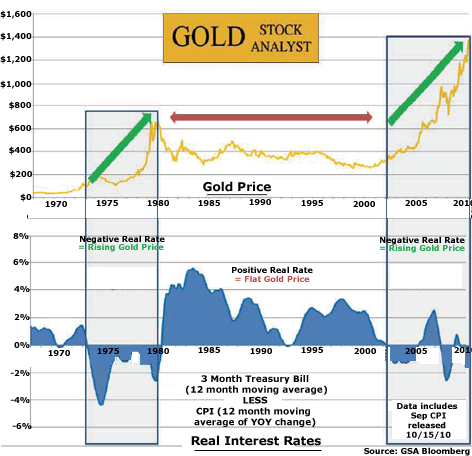| Home | About Us | Resources | Archive | Free Reports | Market Window |
The Best Gold Indicator Around Still Says "Buy Gold"By
Friday, October 22, 2010
Now that gold has soared from $1,200 an ounce to $1,350 an ounce, investors interested in gold are worried they're buying at the top.
While I'm much more focused on buying cheap gold mining assets in my Gold Stock Analyst advisory, I know "newbies" want the comfort of a single indicator to forecast gold's future before they climb on board.
I've studied the gold market for over 30 years. I've seen it boom and I've seen it bust. And my work says the "Real Interest Rate" is the best forecasting tool for looking at the big picture in gold.
Right now, this indicator is saying it's still a good idea to buy gold.
The Real Interest Rate is the risk-free return on money, adjusted for inflation. It's what you can earn on your cash in the bank.
I determine the Real Interest Rate by subtracting the Consumer Price Index (CPI) from the three-month Treasury yield. The CPI is the government's gauge of inflation... or how much purchasing power your cash is losing per year. The three-month Treasury yield is the benchmark yield folks can get on their cash.
When the result of subtracting the CPI rate from the three-month Treasury yield is positive, gold is flat (middle area in chart below). Remember... gold pays no interest. If money in the bank is paying a good interest rate, holding cash is more attractive than holding gold.
 When the result is negative – when you are sacrificing nothing in interest by owning gold – as the 1970s and 2000s boxes show, the gold price soars. This is because money loses purchasing power in a negative Real Interest Rate environment and investors seek the protection of "hard assets."
As you can see from the lower right-hand corner of the chart, we are still in an era of negative Real Interest Rates. At the current +1.1% CPI and a typical 0.1% money market yield, $100 at the start of the year will have only $99 in purchasing power at the end.
I see a negative Real Interest Rate condition for the next several years... as the Fed will be unable to raise interest rates due to the high U.S. unemployment rate. And even when the Fed begins raising rates, if it lags the CPI increases as it did in the 1970s, gold will still move higher.
Yes, gold has enjoyed a big run in the past few months. But the Fed is committed to keeping interest rates low for years. So gold has years more to run... and so do gold stocks.
Regards,
John Doody
Further Reading:
Steve Sjuggerud has a proven gold strategy that would have turned $10,000 into $2 million over the last 40 years. It takes just a few minutes per month to follow... and it's super-safe. "Not only did this Simple Strategy dramatically outperform the price of gold," Steve writes, "it did so with substantially less volatility..." Read more here: Turn $10,000 into $2 Million with My Simple Gold Strategy.
Market NotesANOTHER DEVELOPMENT IN "BIG TECH BOTTOMS" Our "big tech" story continues today... This time, it's Microsoft that's ready to leave its bottom behind.
On Tuesday, we highlighted how Google's skyrocketing share price is displaying the power of our September "big tech is cheap and bottoming" idea. Before its price surge, Google was in a small group of dominant tech firms with lots of cash, big profit margins, and low valuations... yet out of favor with growth-focused investors. The stock's recent 33% rally cured that "out of favor" condition.
Another one of our big tech cheapies, Microsoft, is still out of favor. Microsoft is such a dominant, entrenched software company, it's like a toll road on computer and Internet usage... Yet it's so cheap relative to cash flow, master stock analyst Dan Ferris calls it the "safest stock in the world."
|
In The Daily Crux
Recent Articles
|

